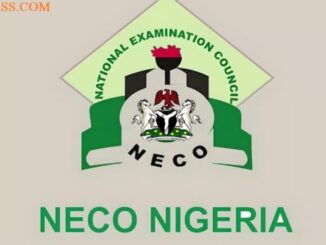Are you searching for the Neco 2025 Fisheries Question and Answer (Objective and Essay)? You’re in the right place! This page provides verified, up-to-date, and accurate answers to help you pass your NECO Fisheries exam with ease.
Thousands of students trust us yearly for NECO Expo, and we’re ready to help you score A1 in Fisheries 2025.

Friday 11th July, 2025
Fisheries (Objective & Essay) 10:00 am – 12:00 noon
FISHERY OBJ:
01-10: ADBCEEECAC
11-20: BCDBDACCCD
21-30: BECBCCECEE
31-40: DDBDAEDAAE
41-50: BBABCBDCAC
51-60: EBDDAEBCAA
(1ai)
A fish pond is an artificial body of water constructed and managed for the rearing and harvesting of fish.
(1aii)
(PICK ANY FOUR)
(i) Availability of water supply
(ii) Soil type
(iii) Topography
(iv) Accessibility
(v) Proximity to market
(vi) Security
(vii) Sunlight exposure
(viii) Environmental safety
(1aiii)
=Differences=
(PICK ANY TWO)
(i) Concrete ponds are built with cement and blocks.
(ii) Earthen ponds are dug directly into the soil.
(iii) Concrete ponds are more expensive to construct.
(iv) Earthen ponds are cheaper and easier to build.
(v) Concrete ponds allow easier harvesting.
(vi) Earthen ponds may be affected by water seepage.
=Similarities=
(PICK ANY TWO)
(i) Both are used for rearing fish.
(ii) Both require proper water management.
(iii) Both require regular feeding of fish.
(iv) Both can be used for breeding and grow-out.
(v) Both need protection from predators.
(vi) Both require regular cleaning and maintenance.
(1bi)
Sketch the diagram
(1bii)
=Pre-stocking practices=
(PICK ANY TWO)
(i) Liming the pond
(ii) Fertilizing the pond
(iii) Removal of unwanted aquatic weeds
(iv) Screening water inlets and outlets
(v) Removal of predators and unwanted species
(vi) Pond drying and preparation
(vii) Testing and adjusting water quality
=Post-stocking practices=
(PICK ANY TWO)
(i) Regular feeding of fish
(ii) Monitoring fish health
(iii) Preventing and treating diseases
(iv) Controlling water quality
(v) Providing aeration where needed
(vi) Protection from predators and poachers
(vii) Regular observation and record-keeping
(3ai) Diagram
Neco 2025 Fisheries Question And Answer (Objective and Essay)
(3aii) (CHOOSE ANY FOUR)
(i) Source of income for fish farmers
(ii) Provides employment opportunities
(iii) Increases protein supply in the diet
(iv) Reduces overfishing in natural water bodies
(v) Promotes rural development
(vi) Provides raw materials for industries (e.g. fish oil, fish meal)
(3aiii)
(CHOOSE ANY TWO)
(i) Both involve human management and care.
(ii) Both may use supplementary. feeding.
(iii) Both aim to increase fish yield.
(iv) Both can use ponds as production systems.
(3bi) Fish feed is any food substance given to fish to support growth, health and reproduction in fish farming systems.
(3bii)(i) Supplementary feed
(ii) Complete feed
(iii) Natural feed (e.g. plankton)
(iv) Artificial/pelletized feed
(3biii) (CHOOSE ANY TWO)
(i) Faster fish growth.
(ii) Higher yield per unit area.
(iii) Better control over water quality and diseases.
(iv) Efficient use of space and resources.
(3biv) (CHOOSE ANY TWO)
(i) High cost of operation and maintenance.
(ii) Requires skilled labor and constant monitoring.
(iii) Increased risk of disease outbreak.
(iv) Water pollution if waste is not managed properly.
Neco 2025 Fisheries Question And Answer (Objective and Essay)
(4ai) (CHOOSE ANY FOUR)
(i) Predation on fish eggs, larvae and fry.
(ii) Reduction in fish hatchery output.
(iii) Increased mortality rate among young fish.
(iv) Stress and injury to fry, affecting growth.
(v) Contamination of water from decomposing prey.
(vi) Disruption of feeding and swimming behavior in fry.
(4aii) Shellfish culture is the controlled cultivation and farming of aquatic animals with shells, such as oysters, mussels, clams and scallops, in natural or artificial water bodies for commercial purposes.
(4bi) (CHOOSE ANY FOUR)
(i) Ichthyophthirius (Ich or White spot disease)
(ii) Trichodina
(iii) Argulus (Fish louse)
(iv) Gyrodactylus
(v) Dactylogyrus
(vi) Lernaea (Anchor worm)
(4bii) (CHOOSE ANY FOUR YOU PICKED FROM 4bi ABOVE)
(i) Ichthyophthirius (Ich)
– White spots on the skin and fins.
– Fish scratching or rubbing against objects.
(ii) Argulus (Fish louse)
– Presence of visible lice on fish body.
– Excessive mucus production and skin irritation.
Neco 2025 Fisheries Question And Answer (Objective and Essay)
(iii) Lernaea (Anchor worm)
– Ulcers or sores on fish skin
– Redness and inflammation around attachment site
(iv) Gyrodactylus
– Excessive mucus on skin
– Eroded fins and skin lesions
(v) Trichodina
– Gasping for air at water surface
– Skin discoloration and sloughing
(vi) Dactylogyrus
– Labored breathing
– Inflamed gills
(4biii)(i) Uniform size of fish due to same growth rate.
(ii) Higher growth rate in some species (e.g all-male tilapia grow faster).
(iii) Easier management and harvesting.
Neco 2025 Fisheries Question And Answer (Objective and Essay)
(5ai) Fish farming is the controlled cultivation and rearing of fish in a confined environment such as ponds, tanks or cages for commercial purposes.
(5aii) (CHOOSE ANY FOUR)
(i) Growth rate of the fish species
(ii) Disease resistance
(iii) Tolerance to environmental conditions (temperature, pH, oxygen)
(iv) Market demand and profitability
(v) Availability of fingerlings or juveniles
(vi) Feeding habits and ease of management
(5aiii) (CHOOSE ANY TWO)
SIMILARITIES
(i) Both are commonly cultured fish species in aquaculture.
(ii) Both can tolerate a wide range of water conditions.
(iii) Both species have high market demand.
(iv) Both reproduce well in captivity.
DIFFERENCES (Neco 2025 Fisheries Question And Answer)
(CHOOSE ANY TWO)
(i) Oreochromis niloticus (Nile tilapia) is a freshwater fish while Clarias gariepinus (African catfish) can tolerate low oxygen conditions better.
(ii) Oreochromis niloticus is mainly herbivorous/omnivorous, whereas Clarias gariepinus is carnivorous.
(iii) Clarias gariepinus has barbels (whiskers) while Oreochromis niloticus does not.
(iv) Oreochromis niloticus prefers warmer water temperatures compared to Clarias gariepinus.
(5bi) Aquatic weed refers to unwanted or invasive plants that grow in water bodies such as ponds, lakes, or rivers and interfere with aquatic life or fish farming activities.
(5bii) (CHOOSE ANY TWO)
(i) They reduce oxygen levels in the water, causing suffocation of fish.
(ii) They compete with fish for nutrients and space.
(iii) They obstruct sunlight penetration, affecting photosynthesis in aquatic plants.
(iv) They clog water inlet and outlet systems, affecting water circulation.
(v) They serve as breeding grounds for pests and parasites harmful to fish.
📝 Neco 2025 Fisheries Question And Answer (Objective and Essay) Final Note
Don’t leave your Neco 2025 Fisheries result to chance. Join thousands of smart students using our trusted platform to succeed. This is your best shot at an A1 in Fisheries.
👉 Subscribe now and receive verified Neco 2025 Fisheries Question And Answer (Objective and Essay)!





I need to answer but i not see it
make payment MR SADAN